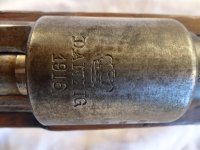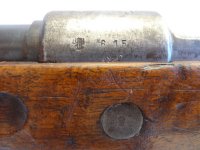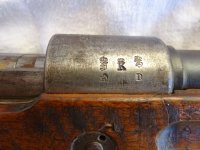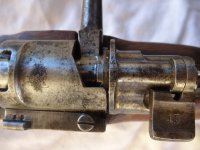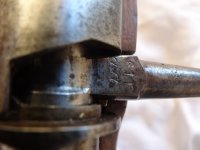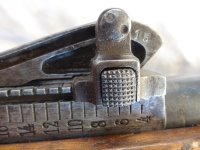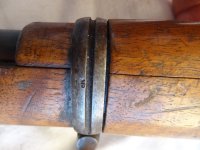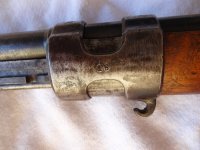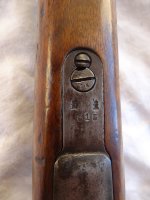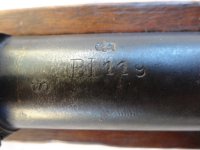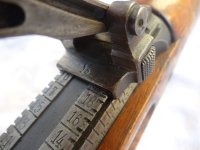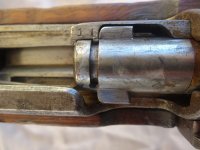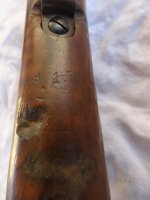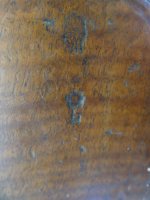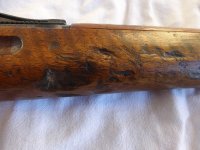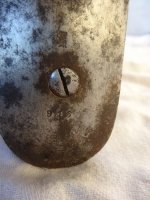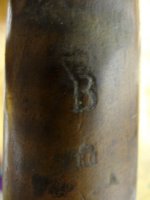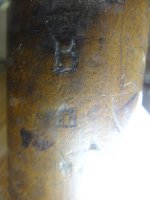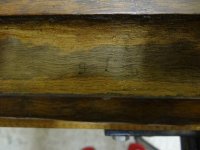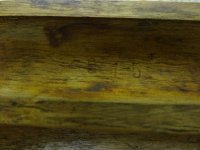You are using an out of date browser. It may not display this or other websites correctly.
You should upgrade or use an alternative browser.
You should upgrade or use an alternative browser.
DANZIG 1916 matching S/N 615aa
- Thread starter toulon44
- Start date
Matching early war Danzig's (all G98 makers actually) are elusive, 1915 very hard to find, 1916 several times more difficult than 1917 matchers... it is true that there are more "matching" 1917 dated known than 1914, 1915 and 1918 combined. These early rifles were typically used up during the early stages of the war and most have one problem or another, usually replaced parts, stocks especially. Your forefathers in France were hard on German rifles...
As to your rifle, unless i am missing something the stock has a different serial? Does it match internally? The acceptance on the stock isn't a known pattern either, though it does have the right characteristics for its range. As far as research goes, walnut with grips is right for this range. Do more pictures of the stock acceptance, there should be an acceptance under the serial, almost always a C/B, the wrist could be good, but the one under cypher is unknown, - though typically they vary the most.
As to your rifle, unless i am missing something the stock has a different serial? Does it match internally? The acceptance on the stock isn't a known pattern either, though it does have the right characteristics for its range. As far as research goes, walnut with grips is right for this range. Do more pictures of the stock acceptance, there should be an acceptance under the serial, almost always a C/B, the wrist could be good, but the one under cypher is unknown, - though typically they vary the most.
just to show you this war horse , if it could talk .... this is a matching DANZIG 1916 not rare but i think that it's interesting .
i'll test it at the range soon .
comments are welcome . thanks
Indeed, early war G98's are difficult to find totally matching and factory original. Danzig's seem especially difficult. DWM, Spandau and Amberg easier, especially 1915's, but the Suhl makers and Danzig are more difficult. You can find them but they are far less common than 1917's, - the good news is most do not seem to know this. When they sell on auction, rarely does the price reflect this fact.
Though it could also be that 1917's are usually found much nicer and condition is what is propping their value up, rarity having less influence. It is doubly tough to find a nice factory original Danzig/1915, most were heavily used. (or abused since)
Though it could also be that 1917's are usually found much nicer and condition is what is propping their value up, rarity having less influence. It is doubly tough to find a nice factory original Danzig/1915, most were heavily used. (or abused since)
My guess is the six is upside down on the buttplate. What would make it less common is that the rifle is matching. Aren't most examples mismatched on some level?
toulon44
Senior Member
The stock is almost for sure Danzig and right for this range, they were an early switcher to roman characters under crowns, dropping Sütterlin and Fraktur, and this shows up early in the war. Whether it is the original stock is more difficult to say, not a huge fan of "factory mismatch" theory, but it certainly happened and is common on late 98k production. Never seen it with an Imperial rifle before, at least i do not have a recollection, but Germans are human and even they make mistakes...
Considering the odds of finding this close of a match, which otherwise is right for the range (something very difficult and few know what would be right acceptance wise, it would be an hell of a coincidence they got it so right... even if you did know what to look for, finding it would be incredibly difficult) I would think it is more likely factory error than a very lucky restorer.
Danzig and Erfurt were also known for their sloppy work, - so if it had to happen with any maker, Danzig or Erfurt would be my top two "most likely" candidates.
Considering the odds of finding this close of a match, which otherwise is right for the range (something very difficult and few know what would be right acceptance wise, it would be an hell of a coincidence they got it so right... even if you did know what to look for, finding it would be incredibly difficult) I would think it is more likely factory error than a very lucky restorer.
Danzig and Erfurt were also known for their sloppy work, - so if it had to happen with any maker, Danzig or Erfurt would be my top two "most likely" candidates.
well thank you , so is it a possible périod marking error ? 615 / 915 are very closed . i've made more pics but here it's night if they are not good enough let me know i'll make other tomorow in the day light . the inner sérial is the same on the handguard and the barrel channel "915"
toulon44
Senior Member
thanks loewe
it seems that you follow my error theory but nobody 'll be abble to confirm this one ,i have noted that the small RC crown control mark found on the stock and the breech housing appears in 1916 between the "i" and "n" letters bloc is it really an only Danzig control mark because i have read that we find it on bad hardening parts used to build weapons ( ref GERMAN SMALL ARMS MARKING page 118 )so why this stamp on the stock ?.
it seems that you follow my error theory but nobody 'll be abble to confirm this one ,i have noted that the small RC crown control mark found on the stock and the breech housing appears in 1916 between the "i" and "n" letters bloc is it really an only Danzig control mark because i have read that we find it on bad hardening parts used to build weapons ( ref GERMAN SMALL ARMS MARKING page 118 )so why this stamp on the stock ?.
C/RC can be found on any component, stocks are less common, but receivers often have them, usually under or above the first position (hardening of receiver). Danzig it is very common, most have a C/RC 1916-1918, and yes it starts to be "common", most common actually, around the k- block of 1916. Prior to that period, it is less common and in 1915 rarely seen.
Danzig is not alone though, C/RC can be found on any maker and any component, it is a correction, Görtz would have the exact meaning, but it essentially means that the component did not meet the standard but was deemed acceptable.
Simson also had a lot of C/RC on their production, I doubt they made a wartime bayonet without one... not sure of their pre-war bayonets, I have only owned and seen a handful. It is a common marking on wartime production.
Danzig is not alone though, C/RC can be found on any maker and any component, it is a correction, Görtz would have the exact meaning, but it essentially means that the component did not meet the standard but was deemed acceptable.
Simson also had a lot of C/RC on their production, I doubt they made a wartime bayonet without one... not sure of their pre-war bayonets, I have only owned and seen a handful. It is a common marking on wartime production.
I think it is a good possibility that this was a factory error, the stock is right for the range, the serial is close and the likelihood of someone being able to find such a stock (with right pattern, acceptance, close serial) is remote. Especially in Europe. That its other parts are original and the consistency of wear throughout also lends credibility to it being original, if not factory then period at least.
But in the end you are right, it can't be proven, and any buyer would consider it mismatched. Which it is, - in our hobby, mismatched is mismatched, probability and theories do not carry great weight when selling a rifle, regardless of how accurate they are.
But in the end you are right, it can't be proven, and any buyer would consider it mismatched. Which it is, - in our hobby, mismatched is mismatched, probability and theories do not carry great weight when selling a rifle, regardless of how accurate they are.
thanks loewe
it seems that you follow my error theory but nobody 'll be abble to confirm this one...
toulon44
Senior Member
C/RC can be found on any component, stocks are less common, but receivers often have them, usually under or above the first position (hardening of receiver). Danzig it is very common, most have a C/RC 1916-1918, and yes it starts to be "common", most common actually, around the k- block of 1916. Prior to that period, it is less common and in 1915 rarely seen.
Danzig is not alone though, C/RC can be found on any maker and any component, it is a correction, Görtz would have the exact meaning, but it essentially means that the component did not meet the standard but was deemed acceptable.
Simson also had a lot of C/RC on their production, I doubt they made a wartime bayonet without one... not sure of their pre-war bayonets, I have only owned and seen a handful. It is a common marking on wartime production.
thank you very much for these explanations


